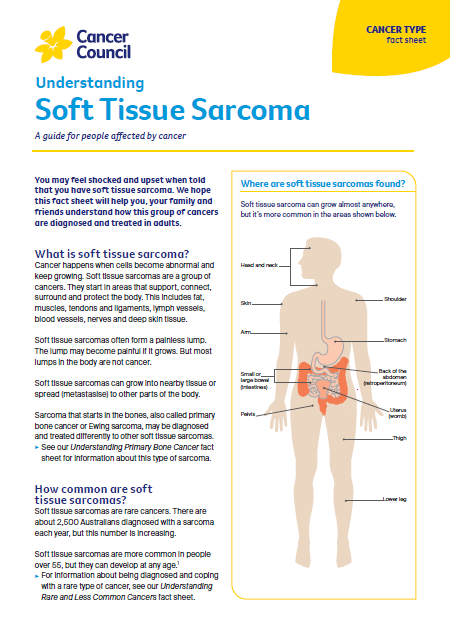- Home
- Soft tissue sarcoma
- Diagnosis
Soft tissue sarcoma diagnosis
Your doctor will ask about your medical history and do a physical examination to feel for a lump. They may also arrange tests or refer you to another specialist for testing.
Learn more about:
Common tests
Common tests include:
| CT (computerised tomography) scan | This scan creates 3D pictures of the inside of your body. You may first have an injection of dye (called contrast) into a vein, to make the pictures clearer. Then, you lie still on a table that moves through a large, doughnut-shaped scanner. This is a painless scan and usually takes about 10 minutes, but the appointment may be longer if contrast is used. |
| MRI (magnetic resonance imaging) scan | Like a CT, this scan creates 3D pictures of the inside of your body. You lie on a table that slides into a long metal tube, which is open at both ends. An MRI takes 30-90 minutes. Some people may feel anxious in the narrow space. You may or may not need an injection of contrast for this scan. |
| X-ray | This painless test takes a few minutes and may be used to check your chest, lungs, abdomen or a limb. It gives less detail than other scans. |
| Ultrasound scan | This scan creates pictures of the inside of your body. It’s used to check lumps in the arm, leg, chest or abdomen. It’s painless, uses no radiation, and is done with a handheld probe that moves over the skin |
| PET (positron emission tomography) scan | This scan helps show if sarcoma has spread to other parts of the body. You’ll be injected with a small amount of harmless radioactive solution. You sit quietly for about 30–60 minutes so the solution can move through your body. The painless scan then takes about 30 minutes in a machine that is open at both ends. The radiation leaves your body after a couple of hours. |
Having a biopsy
A biopsy is the only way to accurately diagnose soft tissue sarcoma. It is important that the biopsy is done by a sarcoma specialist, or at a sarcoma unit.
A biopsy is done if a scan shows signs of sarcoma, or if your doctor feels a lump that may be a sarcoma. During a biopsy, a small sample of tissue or cells is taken and sent to a laboratory for testing.
The type of biopsy you have will depend on where the lump is, and how big it is.
Core needle biopsy – This is done under a local anaesthetic using an ultrasound or CT scan as a guide. A needle is inserted into the lump to take a sample. It uses a core needle, not a fine needle.
Surgical biopsy – This is usually done under a general anaesthetic (when you are asleep). The surgeon makes a small cut in the skin to remove a sample from the lump.
Staging sarcoma
Staging is the process doctors use to describe how far the cancer has grown, whether it has spread and the risk of it coming back. The stage is based on the below.
| grade size | describes how abnormal the cells look under a microscope. Most sarcomas are graded from 1 to 3 (low, intermediate, high). A higher grade means the sarcoma is likely to grow and spread more quickly describes the size of the tumour from imaging scans and how far it may have spread (e.g. to the lungs) |
| location | describes where in the body the tumour is, for example, in a limb or the abdomen. Superficial sarcomas in or just under the skin have a lower risk. Deep sarcomas within muscles or areas such as the abdomen usually have a higher risk |
Knowing the stage helps doctors plan the best treatment for you. How the stage is described may vary depending on the type of sarcoma and where in the body it is. Talk to your doctor about what the stage means and how if affects your treatment.
Treatment at a specialist sarcoma unit
If your doctor thinks you may have sarcoma, you should be referred to a specialist sarcoma unit, including for a biopsy. These units provide expert care, and research shows they have better outcomes. Here you’ll be treated by a multidisciplinary team (MDT). Find a list of sarcoma units and MDTs on the Australia and New Zealand Sarcoma Association (ANZSA) website at sarcoma.org.au. Rare Cancers Australia’s directory, rarecancers.org.au, may also have useful contacts.
→ READ MORE: Treating soft tissue sarcoma
Podcast: Tests and Cancer
Listen to more episodes of our podcast for people affected by cancer
Video: Understanding cancer tests, treatment and support
Being told you have cancer can be overwhelming — but you’re not alone. This video explains what happens after a diagnosis, the different treatment options, and how Cancer Council can support you. Click on Settings ![]() to turn on auto-generated subtitles in your language.
to turn on auto-generated subtitles in your language.
More resources
A/Prof Richard Boyle, Orthopaedic Surgeon, Royal Prince Alfred Hospital and Sydney Children’s Hospital Network, NSW; Catherine Chapman, Adolescent and Sarcoma Cancer Specialist Nurse, Canberra Health Services, ACT; Belinda Fowlie, Bone Tumour Nurse Practitioner Candidate, SA Bone and Soft Tissue Tumour Unit, Flinders Medical Centre, SA; Leanne Goegan, Consumer; Jonathan Granek, Consumer; Prof David Gyorki, Surgeon and Director, Sarcoma Service at Peter MacCallum Cancer Centre, VIC; Prof Angela Hong, Radiation Oncologist, Chris O’Brien Lifehouse, Melanoma Institute Australia, GenesisCare and Clinical Professor, The University of Sydney, NSW; A/Prof Yeh Chen Lee, Medical Oncologist, Prince of Wales Hospital and UNSW, NSW; Caitriona Nienaber, 13 11 20 Consultant, Cancer Council WA.
View the Cancer Council NSW editorial policy.

